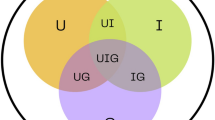Abstract
Significant attention has been given to advancing cyber-infrastructures to support virtual engineering and science communities based on the proposition that virtual organizations can more effectively create and leverage knowledge due to diverse information, skills, and resources to enhance capacity to innovate. Yet, relatively little is known about desirable organizing processes in virtual open science communities. To this end, a simulation-based exploratory study is conducted to better understand the conditions that confer increased rates of innovation in such socio-technical systems. Three types of open science communities are identified and simulated using agent simulation as a method of inquiry. Simulation results show that centrality, as a measure of degree of connectedness, correlates with innovation output in exploratory and service communities up to a point. Also, utility-oriented communities have social network structures with low density and high centrality, which suggest high potential for innovation.
Similar content being viewed by others
Explore related subjects
Discover the latest articles and news from researchers in related subjects, suggested using machine learning.References
Amabile MT (1996) Creativity in context: update to the social psychology of creativity. Westview, Boulder
Bos N, Zimmerman A, Olson J, Yew J, Yerkie J, Dahl E, Olson G (2003) From shared databases to communities. Technical report, Oxford Technical Institute
Brown SJ, Duguid P (1991) Organizational learning and communities-of-practice. Organ Sci 2:40–57
Brown SJ, Duguid P (2000) The social life of information. Harvard Business School Press, Boston
Brown SJ, Duguid P (2001) Knowledge and organization: A social practice perspective. Organ Sci 122:198–213
Burt SR (1992) Structural holes. Harvard University Press, Cambridge
Carley KM, Martin MK, Hirshman BR (2009) The etiology of social change. Top Cogn Sci 1(4):621–650. doi:10.1111/j.1756-8765.2009.01037.x
Cowan R, Jonard N (2004) Network structure and the diffusion of knowledge. J Econ Dyn Diffus Knowl 28:1557–1575
Crane D (1972) Invisible colleges: diffusion of scientific knowledge in scientific communities. The University of Chicago Press, Chicago
Csikszenthmihalyi M (1999) Implications of a systems perspective for the study of creativity. In: Handbook of Creativity, pp 313–338
David PA, Spence M (2003) Toward institutional infrastructures for e-science: The scope of challenges. Technical report, Oxford Technical Institute
Dhanaraj C, Parkhe A (2006) Orchestrating innovation networks. Acad Manag Rev 31(3):659–669
Edmonds B (2007) Artificial science—a simulation to study the social processes of science. In: Social simulation: technologies, advances and new discoveries, pp 61–67
Foster I (2005) Service-oriented science. Science 308:814–817
Gilbert N (1997) A simulation of the structure of academic science. Sociological Research Online 2(2), http://www.socresonline.org.uk/socresonline/2/2/3.html
Gordon MD, Lindsay RK (1996) Toward discovery support systems: A replication, re-examination, and extension of swansons work on literature-based discovery of a connection between Raynaud’s and fish oil. Am J Sociol 47(2):116–128
Granovetter M (1973) The strength of weak ties. Am J Sociol 78(6):1360–1380
Hargadon A, Bechky B (2006) When collections of creatives become crative collectives: A field study of problem solving at work. Organ Sci 17:177–192
Harrison JR, Carroll GR (2006) Culture and demography in organizations. Princeton University Press, Princeton
Holland JH (1995) Hidden order: how adaptation builds complexity. Perseus Books, Culver City
Kilduff M, Corley KG (2000) Organizational culture from a network perspective. In: Handbook of organizational culture & climate, pp 211–221
Kilduff M, Tsai W (2006) Social networks and organizations. Sage, Thousand Oaks
Maanen JV, Barley RS (1984) Occupational communities: Culture and control in organizations. Res Organ Behav 6:287–365
Mann GS, Mimno D, McCallum A (2006) Bibliometric impact measures leveraging topic analysis. In: Proceedings of the 2006 JCDL conference, pp 25–34
Miller JH, Page SE (2007) Complex adaptive systems: an introduction to computational models of social life. Princeton University Press, Princeton
NanoHUB (2009) Network for computational nanotechnology. http://nanohuborg/
Perry-Smith JR, Shalley CA (2003) The social side of creativity: A static and dynamic social network perspective. Acad Manag Rev 28(1):89–106
Powell WW, Snellman K (2004) The knowledge economy. Ann Rev Sociol 30:199–220
Rogers EM (2003) Diffusion of innovations. Free Press, New York
Simard C, West J (2006) Knowledge networks and the geographic locus of innovation. In: Open innovation: researching a new paradigm, pp 220–240
Smith B, Ashburner M, Rosse C, Bard J, Bug W, Ceusters W, Goldberg LJ, Eilbeck K, Ireland A, Mungall CJ, Consortium TO, Leontis N, Rocca-Serra P, Ruttenberg A, Sansone SA, Scheuermann RH, Shah N, Whetzel PL, Lewis S (2007) The OBO foundry: coordinated evolution of ontologies to support biomedical data integration. Nat Biotechnol 25(11):1251–1255
Stankiewicz R (1992) Technology as an autonomous socio-cognitive system. In: Dynamics of science-based innovation. Springer, New York
Tenenbaum M, Willbanks J (2008) Therapy development in a networked world: Introduction and overview. Science commons technical report
Ward TB, Smith SM, Vaid J (1997) Conceptual structures and processes in creative thought. In: Creative thought: an investigation of conceptual structures and processes, pp 1–30
Wenger E (1998) Communities of practice: learning, meaning, identity, Cambridge. Press, New York
Ye Y, Nakakoji K, Yamamoto Y, Kishida K (2005) The co-evolution of systems and communities in free and open source software development. In: Free/open source software development, pp 59–82
Author information
Authors and Affiliations
Corresponding author
Rights and permissions
About this article
Cite this article
Zou, G., Yilmaz, L. Dynamics of knowledge creation in global participatory science communities: open innovation communities from a network perspective. Comput Math Organ Theory 17, 35–58 (2011). https://doi.org/10.1007/s10588-010-9068-0
Published:
Issue Date:
DOI: https://doi.org/10.1007/s10588-010-9068-0




